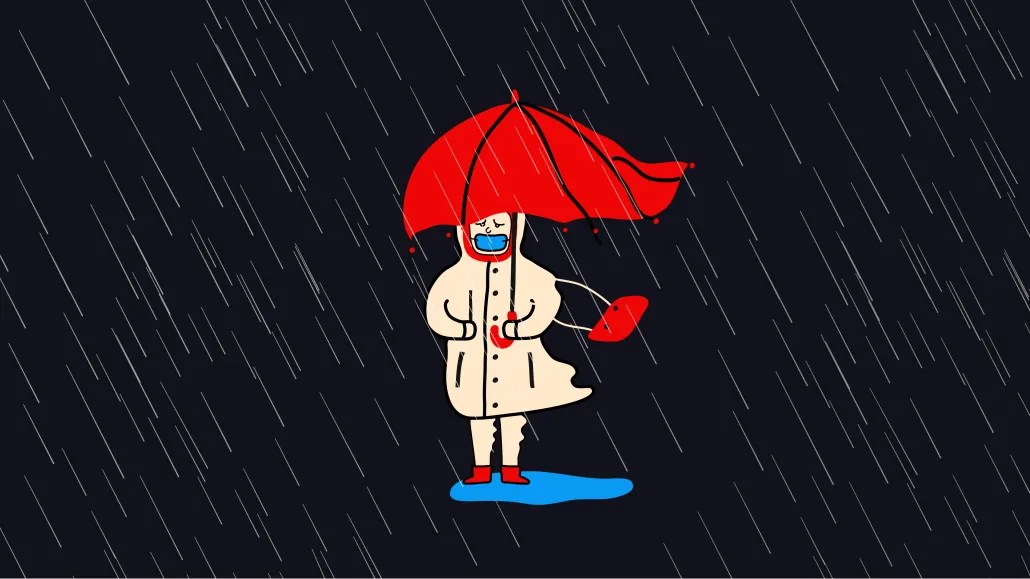Retailers are increasingly blaming bad weather for weak sales

Come rain or shine, a perennial scapegoat for retailers’ poor performance has proven to be the weather.
In January, Investors’ Chronicle found 23 recent instances of retailers citing weather patterns in their quarterly financial reports. Some of the citations were positive, but the majority of the companies blamed unseasonable weather for low sales.
For instance, in January boots maker Dr Martens pointed to the warm temperatures across the U.S. last fall as a reason for weak boots sales. For its fourth quarter, the brand experienced a 21% drop in revenue year-over-year. Dr Martens cited similar reasoning the previous year, blaming slow boots sales on “unseasonably warm weather” during fall 2022. Also in January, sneakers retailer JD Sports issued a profit warning, saying that mild weather and heavy promotions hurt its holiday period sales.
It is true that bad weather can sometimes rain on the parades of retail earnings forecasts. Weather does factor into people’s decisions when shopping for new clothing or shoes. Fashion and apparel brands plan their buying cadence based on seasons, anticipating that people will want to start buying swimsuits in the spring and coats in the fall. And that buying cycle can get thrown out of whack thanks to unseasonably warm or cold weather. However, unusual weather isn’t typically the sole reason for a company’s weak sales — and, sometimes, it can be used as a scapegoat for other fundamental business issues.
Nonetheless, as climate change continues to wreak havoc on the seasons, brands may have to adapt theirplanning cycles as people may seek to buy items during different times of the year than they have historically.
These latest performance warnings from retailers kicked off long before winter arrived. Last September, for example, H&M was already blaming the unseasonably warm autumn weather in the United States to Europe for putting a dent in its revenue heading into fall and winter. The company said September sales would see a 10% drop compared to the previous year.
“It’s clear that more heavy autumn product types are the ones where we see a delay in selling,” H&M CEO Helena Helmersson told Reuters at the time. “We know that we can’t draw big conclusions after one month.”
Between September and November, H&M’s net sales did end up falling 4% compared to the same period in 2022.
Neil Saunders, managing director of GlobalData Retail told Modern Retail that in general, the weather does have a very direct impact on the demand for certain products. “Warmer or colder weather influences how much people need certain types of clothing,” he said. “So if there is a big deviation from seasonal norms, it is reasonable for retailers to call it out.”
However, Saunders added the weather is “a very easy excuse to roll out,” and such pleas by retailers have to be properly assessed. “Sometimes, it is used to hide poor buying decisions or other missteps,” he added.
In H&M’s case, the performance of competitor Zara contradicts its weather-related justification for poor sales. Between August 1 and September 11, Zara owner Inditex saw sales increase by 14% around the same period. Similarly, for denim maker True Religion, the prolongment of summer 2023 turned out to be an advantage — with short-sleeve tops and shorts continuing to sell well going into the end of September.
Weather is also often cited by retailers as a reason their customers take fewer shopping trips. March 2023 ended up being the “sixth wettest March since 1836” according to the BBC. As a result, a number of U.K.-based retailers said that fewer shoppers headed to stores that month.
A similar dynamic played out in the region during last month’s “soggy February.” Foot traffic was down at stores, pubs and restaurants. But, the rainy weather helped boost takeout and fast food as people got cozy at home.
As a result, combined food and non-food spending resulted in the U.K.’s February retail sales increasing by 1.1% month-over-month. That was slightly down from the 1.2% monthly growth reported in January, and the 1.7% increase recorded in December.
As winter winds down, retailers are looking to rising temperatures to help bring out customers. But even with the last week of February showing glimpses of spring, foot traffic still underperformed overall across the U.S., thanks to a blizzard on the West Coast that offset pleasant weather in other regions.
According to TD Cowen, the fourth week saw U.S. retail traffic decelerate to a 0.9% increase year-over-year, compared to a 1.6% spike the prior week. In a note highlighting the disappointing figures, TD Cowen managing director and senior equity research analyst Oliver Chen said the warm and wet start to March will continue to negatively impact store traffic. Snow and wind in the western part of the country and shower storms in the east will continue to cause sluggish traffic. However, Chen said, “warmer spring temperatures in the Central and eastern U.S. should be favorable for spring categories like apparel.”
With the climate expected to further impact retail activity, companies are expected to adjust their merchandising and operations to attract customers – even in bad weather.
Certain categories are impacted differently based on weather forecasts, as evident by grocery and apparel spending. But retailers scapegoating Mother Nature don’t always offer concrete evidence.
“I think weather excuses must be specific,” Saunders said. “Generally calling out the weather for reduced foot traffic or general sluggishness is often very weak.”

